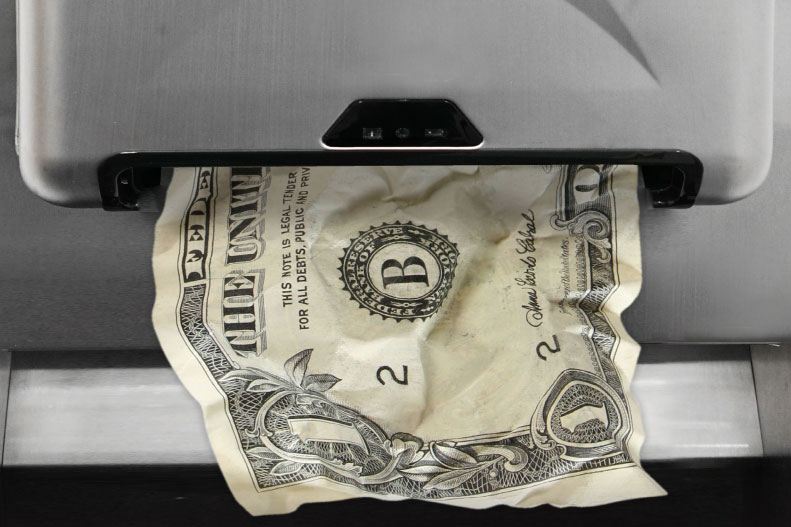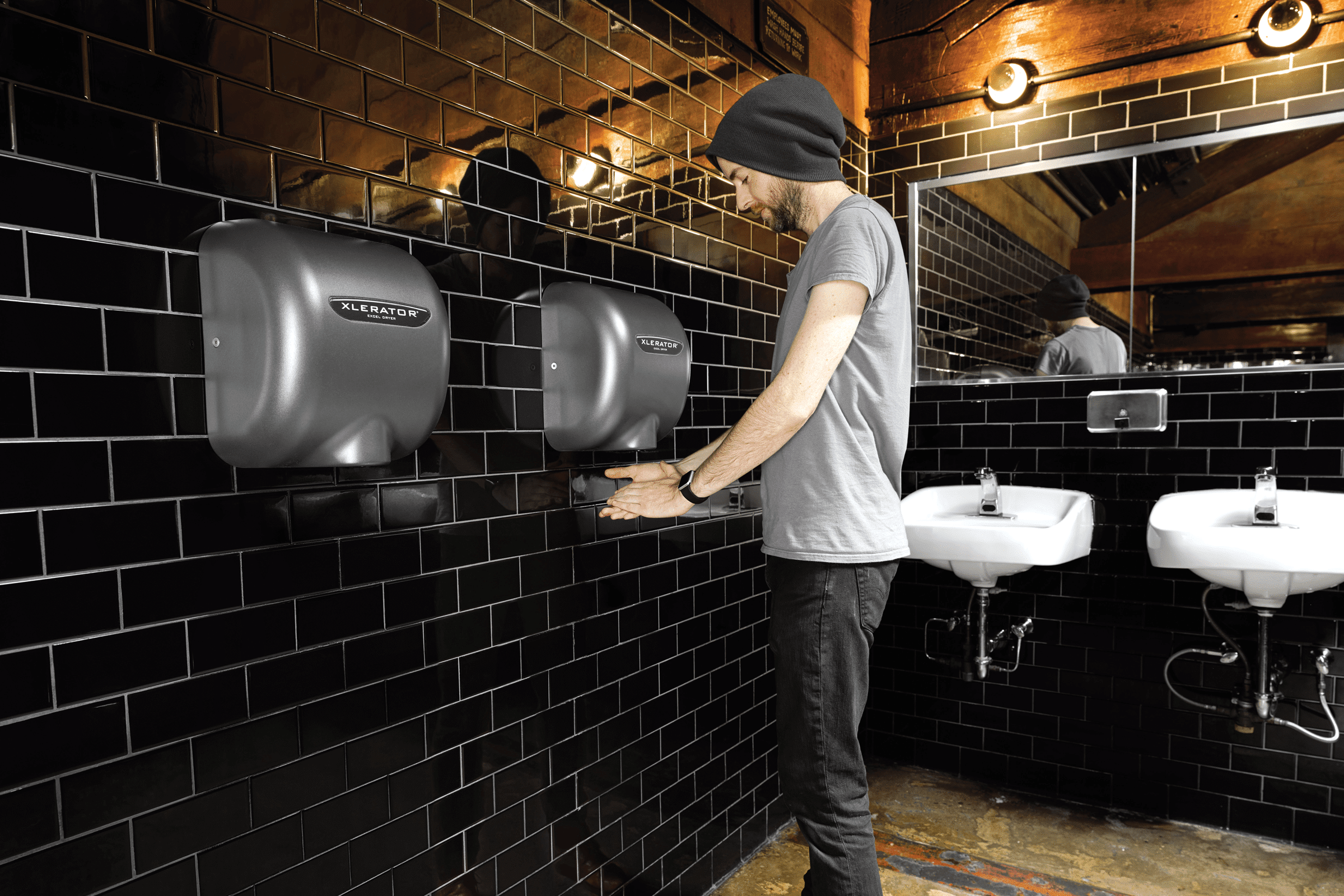Story at a glance:
- Restrooms make a major impression when people visit offices, restaurants, and other venues.
- Touchless technology is making many washrooms more efficient and more aesthetically pleasing.
- Most air dryer installations have a ROI of around 12 months, depending on user traffic.
Who knew restrooms could be so complicated and, sometimes, controversial?
Building facilities managers, that’s who. Not only do washrooms create a lasting impression on occupants and visitors—be it in office buildings, restaurants, sports venues, health clubs, hospitals, hotels, event spaces, or public transportation stations— but they can be a significant cost item in their operations.
Contemporary technologies and materials have improved on the bathrooms of yore, of course. Touchless functions on toilets flushers, soap dispensers, and hand drying amenities (air dryers and paper towels) are increasingly common. These matter because bathroom users are aware of the surface germs present in places where human waste is pretty much the purpose of the room.
Paper Towels vs Electric Hand Dryers

Photo courtesy of Excel Dryer
But there remains a divide on the matter of hand drying: paper towels or warm air dryers? What about both? Which works best for users, and which works best for facilities managers? Which is better for the environment?
It helps to break down these questions into specific “pain points”—that is, places where a facilities operator has to make hard decisions and, perhaps, deal with headaches:
Overall Cost
It should be obvious that simple paper towel dispensers, needing no electrical conduit, are less expensive at installation than high-speed energy-efficient dryers (e.g., the Excel Dryer XLERATOR). But that’s really a small part of the equation.
“Cost savings over time is the number one issue in most industry verticals,” says Damien Wilmer, business development manager/East Coast for Excel Dryer.
Based on large-scale customer experience, the operating costs with electric hand dryers are just 5% of a restroom’s operating expenses with paper towels. In other words, the facility that spends $1,000 per month on paper towels and its associated maintenance would only spend $50 in electricity costs. In most air dryer installations the ROI is around 12 months, depending on user traffic, Wilmer says.
Of course, electricity costs vary by region and utility company, and for buildings not drawing power from onsite renewable energy like a solar system. Wilmer says the air dryer cost per use is less than one cent ($0.01).
General Maintenance
The difference between paper towels and electric hand dryers, from a maintenance standpoint, is dramatic. Electric hand dryers essentially eliminate the maintenance costs of receptacle disposal, restocking, and floor cleanup. In a time of tight labor supply, this is a real concern for facilities managers.
Emergency Maintenance
It’s fairly common for public and employee washrooms to have clogged drains, especially from the toilets. This phenomenon can halt an operation, particularly if there is no alternative washroom for employees (OSHA sanitation standards 29 CRF 1926.51 require employers to repair or replace non-functioning toilets as soon as possible).
What clogs drains? That could be just about anything, but with great frequency it is paper towels (e.g., when a user lines the seat with paper towels to avoid contact with it). When an electric hand dryer replaces paper towels the risk for this is greatly reduced.
User Satisfaction and Hygiene
As mentioned, a public restroom can be a source of pathogens—naturally leading users to be concerned about getting sick from a toilet, sink, fixtures, and other surfaces. Research shows that public washrooms have bacteria (including E.coli, Salmonella, and Staphylococcus aureus), viruses (including norovirus and influenza), and fungi (including Aspergillus and Candida). The CDC states that hand-washing needs to include hand drying because “germs spread more easily when hands are wet.”
Touchless fixtures improve on this significantly; some paper towel dispensers have touchless dispensing features, as do all high-speed electric hand dryers.
To the question of user satisfaction, it bears noting that earlier (1950s to 1990s) versions of electric hand dryers were too slow at drying hands. The modern XLERATOR dryer, which provides high-speed warm air, is much more efficient at performing its task. It also offers a cleaner aesthetic overall.
Paper towels might be the preference of some users. That said, their overall satisfaction plummets if the paper towels are depleted or cluttering the floors from an overflowing waste bin.
Environmental Concerns and Perceptions
Increasingly building occupants look for signs that the structure they occupy is as kind to the environment, with a minimal carbon footprint, as is possible. The LEED and WELL Standard certifications have raised awareness about this considerably.
But sometimes there is a “greenwashing” factor—a claim that something is greener than it really is. It takes work to dig into such things as supply chains and waste disposal to understand if and when a product or building is in fact as good for the environment as claimed.
Excel Dryer undertook a Life Cycle Assessment (LCA), which investigates the total environmental impact of its dryers from the time of manufacturing through use and disposal. A third-party research firm, Quantis, conducted the study. The net findings: compared to traditional (slower) electric dryers and paper towels (both virgin and recycled content) the XLERATOR Hand Dryer reduced the carbon footprint by 50 to 75%. The reduction as measured was from fossil fuel-generated electricity; the CO2 reduction is even greater with renewable energy like rooftop solar as a power source.
The USGBC even awards LEED points for the XLERATOR dryer. It is that sustainable. A variation on the product, the XLERATOReco Hand Dryer, uses even fewer watts (500) by eliminating heat from the airflow.
It bears noting that “recycled paper towels” include waste recovery, re-manufacturing, hauling, and waste disposal steps, each of which has a carbon cost. And once used they are sent to a landfill (i.e. the recycling ends there because the quality of the material after use is poor).
Pain-Free Modern Restrooms

Photo courtesy of Excel Dryer
Something called a “restroom” should not be a source of headaches, added labor, and potential OSHA violations. The modern public bathroom needs to be clean, efficient, green, and functional—and not an unnecessarily costly part of the overall building operation. Discerning between the myths and realities of the hand-drying service to guests can go a long way to improve on all these points.


